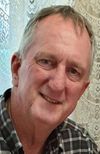Going to sea with Rowdy Wylie and Nicolas Baudin on the S.S. Casuarina
We know the artist and AnArt4Life contributer Rowdy Wylie as a man who loves country, the very earth we walk on. And the more arid and red the ground is, the happier he seems to be - as we have seen in the wonderfully rich and deep narrative landscape paintings he creates, particularly of South Australia.
And then Rowdy sends me Casuarina- and I’m in love, as I believe the most beautiful of all human made structures is the sailing ship. The beauty in the overall composition of these vessels is breathtaking and the marriage of wood, copper, brass, iron and a flax or cotton canvas is just perfect.
Rowdy has captured the beauty and courage of these mistresses of the ocean in a most dramatic way.
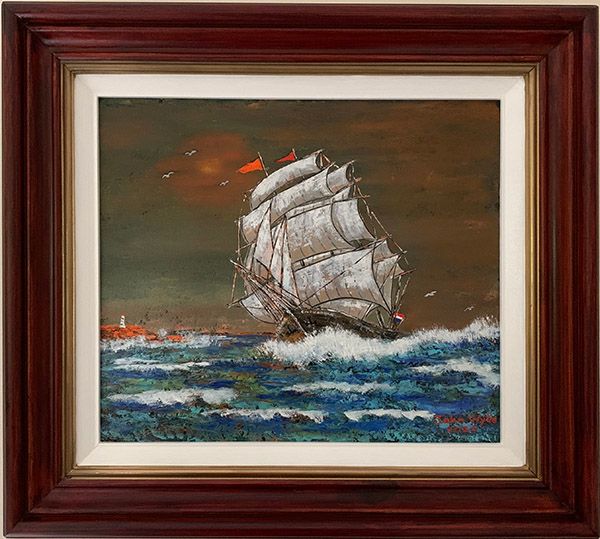
But the appeal isn’t just about aesthetics- sailing ships have a narrative, an intriguing history both officially documented but also for many of us colonials - a very personal story. If it weren’t for sailing ships I wouldn’t be an Australian as I am a fourth generation Aussie immigrant child. But this post isn’t about me- it’s about Rowdy and his love of ships and boats.
Where did this passion come from? Rowdy, another multiple gen immigrant child comes from sailing folk. I will let Rowdy take over the story…
Rowdy:
As a young lad I grew up in a family… of many relatives from Port Adelaide… which is a region that has a very “strong tradition” of workers on the wharfs and many who were seafarers…
One outstanding cousin, Alan Workman, was a Sea Captain working as a “Pilot” with the Department of Marine Harbours and he captained the schooner/ketch “Falie” around the South Australian coastline in 1986 to celebrate the 150th Jubilee Anniversary of South Australia…. Another relative sailed as crew on the old “Tall Ships” climbing the rigging… setting sails in the late 1800s early 1900s…. Many others worked in the Australian Navy and Merchant Navy….
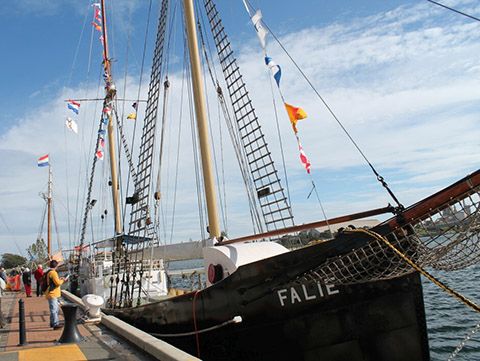
Rowdy explains:
My fond memories of our family home which was in inner Adelaide included a magnificent print on the wall of our lounge room of a “Tall Ship” in full sail… sailing past an island with a lighthouse..
The visual narrative had lots of drama with orange stormy skies… the sea was black…. with rows of wild waves & white sea spray!!! And the picture was 'housed" in a magnificent carved "Gold Frame"....
Throughout my youth I was always admiring this composition and I can remember saying to myself… “I will one day paint this tremendous scene”… So in my retirement… I have done it!!!
In constructing and executing the composition of the Casuarina Rowdy chose to...
encompass this "Tall Ship" in full sail…. And in an environment of “high seas”… strong winds and stormy skies… As this is something to behold… a scene full of action, drama… excitement and adventure… all the elements we associate with these magnificent ladies...
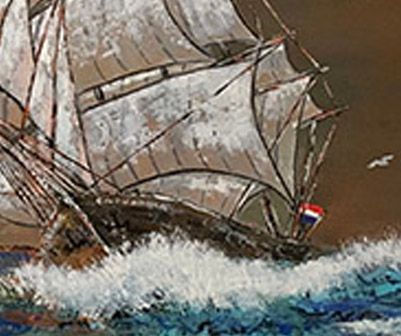
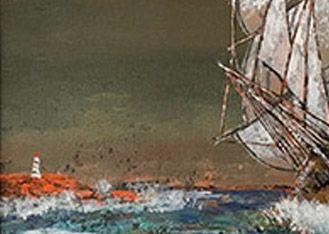
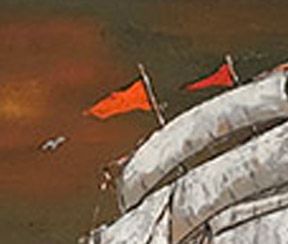
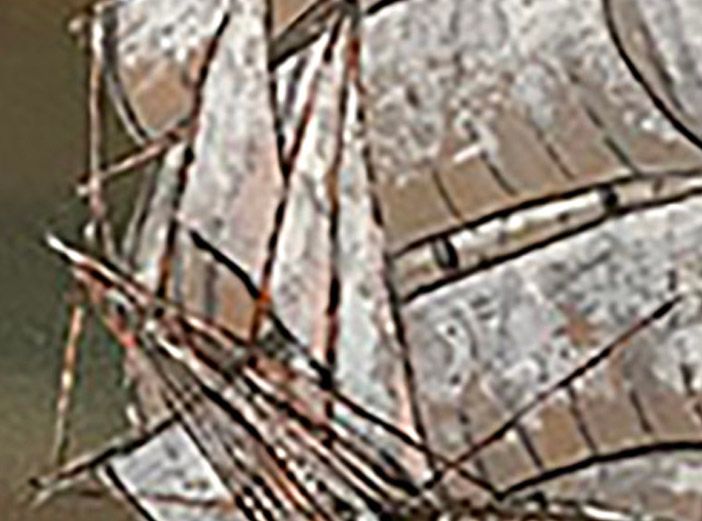
Rowdy continues:
My love of sailing vessels matured and extended to working on boats …… repairing and building small sailing boats and sailing for many years ... Much of my youth was spent in and around the Port of Adelaide and Outer Harbour.....so sketching ships & yachts I find quite straight forward.... Although.... “oil painting” them in a seascape is an enjoyable challenge....
This was a very enjoyable composition to paint...Painting from my childhood memory, reflecting on the images I had stored in my mind… with the final inspiration coming from reading the history and the narrative associated with the "Casuarina" and French explorer, Nicolas Baudin's sea voyage to map the unknown coasts of Australia.
Anne interjects:
I had never heard of Nicolas Baudin or the Casuarina. How would I? The British won the race and the history pages of Australian European settlement- and Nicolas was French!!
For our school history diet Captain James Cook was served up for most main courses (!!!!) and his fellow countryman Matthew Flinders (who took his cat Trim to sea with him), would be served as dessert.
The Dutch and French were also circling this large and beautiful country so we were nearly a Dutch or French colony so let us learn a little more about Nicolas Baudin and the Casuarina which Rowdy believes was probably a small “service ship” which could sail closer to land in the bays and shallower water in the harbours etc…. The Casuarina was made from the Australian native “Casuarina (Sheoak)”… tree...hence its name.
In October 1800, Baudin was selected by Napoleon Bonaparte to lead what has become known as the Baudin Expedition to map the coast of New Holland. He had two ships, Géographe and Naturaliste captained by Hamelin, and a suite of nine zoologists and botanists. 2
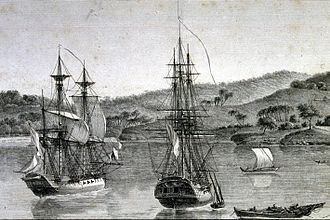
Baudin left Le Havre on 19 October 1800, stopped off in Santa Cruz de Tenerife, then sailed straight to the Ile de France arriving on 15 March 1801, 145 days later. The voyage, overlong with early rationing left sailors and scientists feeling discouraged, but the colony was happy to build up the crews in case of conflict and to make use of the new skills they brought with them. He reached Australia in May 1801, and would explore and map the western coast and a part of the little-known southern coast of the continent. The scientific expedition proved a great success, with more than 2,500 new species discovered.2
In April 1802 in Encounter Bay (present-day South Australia) Baudin met Matthew Flinders (and no doubt Trim, the cat), who was also engaged in charting the coastline.
Baudin then stopped at the British colony at Sydney for supplies, and from there he sent home the Naturaliste, carrying all of the specimens that had been collected by both ships up to that time. According to recent research by academics from the University of Adelaide, during Baudin's expedition, François Péron, who had become the chief zoologist and intellectual leader of the mission, wrote a report for Bonaparte on ways to invade and capture the colony.2
Realising that Géographe could not venture into some of the shallow waters along the Australian coast that he (Baudin) was intending to survey, he bought a new ship, Casuarina, named after the wood it was made from, and placed it under the command of Louis de Freycinet, who would 15 years later make his own circumnavigation of the world in the corvette l'Uranie. Baudin then headed back to Tasmania, before continuing along the southern and western coasts of Australia to Timor, mapping as he went. In very poor health, he then turned for home.2
Baudin died of tuberculosis at Mauritius on 16 September 1803, at the age of 49, apparently in the home of Madame Alexandrine Kerivel. Baudin's exact resting place is not known, but the historian Auguste Toussaint believed that he was interred in the Kerivel family vault. However, the historian Edward Duyker likes to think that Baudin was buried in Le Cimetière de l’Ouest in the district of Port Louis, "just a few hundred metres from the explorer’s certain love: the sea".2
Rowdy's postscript:
I first learnt about the “Casuarina / She-oak” tree many years ago at “Camp Coorong” near Meningee, south of Tailem Bend South Australia…… which is an Aboriginal - Ngarrindjeri Country… student educational enterprise… I participated with a group of young Aboriginal youth from Port Adelaide learning about “bush tucker” from the camp “Elders”…. The Casuarina tree was part of the flora we studied.
I believe the Casuarina's final resting place is in the country of Mauritius ...where it was abandoned following the death of Nicolas Baudin.
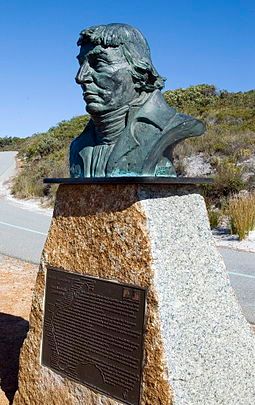
Credits
1.weekendnotes.com
2. en.wikipedia.org

